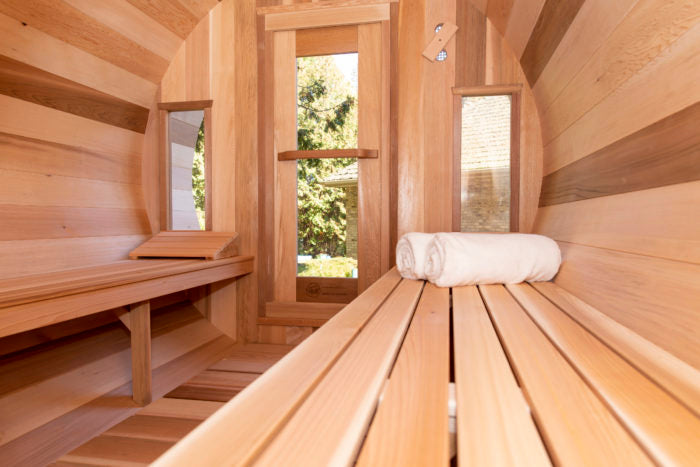The Main Principles Of Traditional Sauna
The Main Principles Of Traditional Sauna
Blog Article
Unknown Facts About Traditional Sauna
Table of ContentsSome Ideas on Traditional Sauna You Should KnowExcitement About Traditional SaunaNot known Factual Statements About Traditional Sauna Some Known Questions About Traditional Sauna.The Ultimate Guide To Traditional Sauna
Most of the weight lost in a sauna is water loss and is re-gained upon rehydrating. Nevertheless, certainly sauna can be a fundamental part of a healthy weight loss program. To check out the distinctions in between standard and IR saunas, I will certainly divide these right into proven, theoretical, and produced differences.Therefore, the most popular point in the saunawhich is at the ceiling directly above the sauna heateris usually between 185 and 190 F. Claims that a standard sauna surpasses 200 F is just not true and not appropriate for electric saunas sold in the United States. The temperature level for a far-infrared sauna is typically established between 120 and 140 F; however, unlike the conventional sauna, the goal in and IR room is not to accomplish a high temperature.
As a result of this, the temperature distinction is virtually unnecessary, considering that excessive sweating leads to both sauna types, yet the technique of heating up the body is different. In an IR sauna the bather will certainly feel hot and will certainly sweat a lot, but at a lot reduced temperature levels. Traditional Sauna. Therefore, if the goal is to invest longer time periods in the sauna, the IR sauna is a good selection

An Unbiased View of Traditional Sauna

When the high temperature level is attained, the components cycle on and off to maintain the high temperature. Traditional Sauna. Many standard sauna customers enjoy pouring water over the rocks to create steam to raise sauna humidity levels. The benefits of pouring water over the rocks include: making the room much more comfortable, moistening the nasal passages, and allowing the use of aromatherapy by mixing important oils with the water
In a far-infrared sauna, the warm waves permeate the body to successfully heat up the body and increase the body core temperature. To achieve this enhanced temperature, Far-infrared emitters produce infrared energy which is close to the same wavelength as that which the body naturally emitsoften described as the "Essential Array" of 7 to 14 microns), so the power is well gotten by the body.
When the power goes into the body, it triggers the body temperature to enhance and eventually leads to perspiration. In an infrared sauna it is essential for the emitters/heaters to remain on practically regularly. Because there is no mass of rocks to maintain warmth, the sauna will cool down if the emitters closed off.
The Best Guide To Traditional Sauna
As discussed above, the sauna bather in an infrared area wishes to read this post here place himself in front of running emitters to get optimal gain from the heat. The home heating time for the two rooms can be extremely different, relying on exactly how the rooms are made use of. For a standard sauna, a bather must allow 30-40 mins for the room to attain a preferred temperature level and to appropriately pre-heat the rocks.
A well constructed sauna will normally achieve a temperature of 150-160 F in concerning 30-40 minutes. For hotter temperatures, the space might Recommended Reading need to warm for a longer duration.

Typical saunas often tend to be larger (thus utilize more electrical power) than infrared saunas, although typical saunas are certainly available in one and 2 individual dimensions also. For a two-person conventional sauna, 5x6 or 5x7 size is most preferred. The leading bench can easily seat two or 3 individuals and is also enough time to exist down during the sauna session.
Traditional Sauna - An Overview
The ordinary cost per kWH of power in the U.S. is approximately $0.11 - Traditional Sauna, so a 4.5 kW heating unit will cost about $.50 to compete one hour, if the heater runs continuously for one hour. Typically a sauna heating system will certainly compete 75% of the very first hour and 50% of succeeding hours on considering that the components cycle once the set temperature level is accomplished
A 2 person far-infrared space is generally physically smaller than a traditional sauna, commonly concerning 4' x 4' or smaller. The IR home heating system is typically 1.5-1.7 kW using a 120 volt 15 amp plug-in solution. Given that the room can be utilized faster than a sauna area, we will assume the space is made use of for to of an hour consisting of heat up time.
Lastly, there is a rarely reviewed distinction in the social experience in between the two spaces. While our culture has actually shed several of the social advantage of the traditional sauna experience, it can be very socially gratifying. From household time in the sauna, to heart-felt conversations with considerable others, link to sauna partiesthe standard sauna experience can bring about intimate mingling.
Traditional Sauna Can Be Fun For Anyone
Most greater end infrared rooms consist of tinted light therapy, sound systems and full-glass fronts.
Report this page